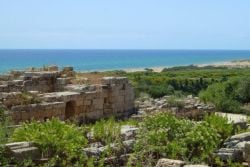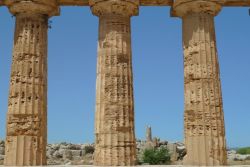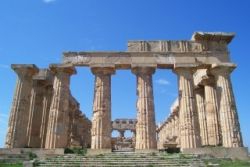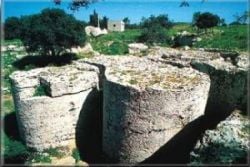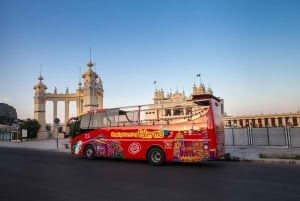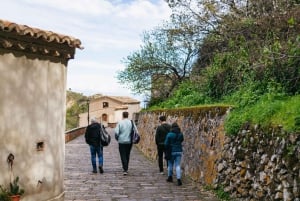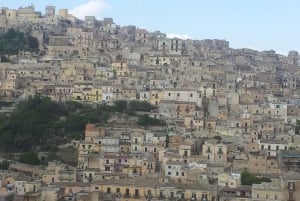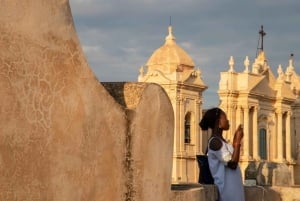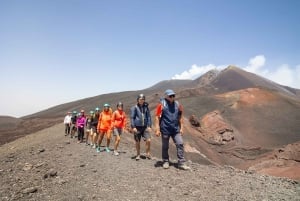Selinunte
Selinunte is the largest archaeological site in Europe, located in the west of Sicily at the seaside, south of the town of Castelvetrano. Seven Greek temples are perching on a plateau, only one is complete – it was reconstructed in 1958. The might of Selinunte’s temples and 25 metre high columns is a popular archaeological site for tourists on Sicily's west coast. This is partly because of the remains but also the spectacular coastal location on which it sits.
The city of Selinunte was one of the most beautiful colonies of ancient Greece, founded in the 7th century BC. There are three tours offered at the ticket office, all by golf cart! So put on your hat, take your water bottle and prepare yourself for some extended sightseeing – all we can say here: it is worth it! Selinunte has lain abandoned for more than 2,000 years – the acropolis, the agora and numerous temples in dignified ruins. If you have a car, visit the temples close to the ticket office on foot. Then drive westward to the farther site – you will have to show your ticket at various stages.
(Video by courtesy of Todaro Net)
In 409 BC the Carthaginians sent an army of about 100,000 men to lay siege to the town of Selinunte, which hold out for nine days. The city was razed, the sacking involved the massacre of 16,000 inhabitants while most of the citizens were taken into slavery. The Greek columns are still marked by burn scars, and much of the city still lies in rubble at its position of collapse. The latest research has shown that the temples were probably not destroyed by war, but fell victim to a massive tsunami - the downside of the wonderful seaside location.
If you visit to Selinunte you will immediately understand why the old Greeks chose this place: the ancient town is located on a high plain that is overlooking the sea. It is flanked by golden sandy beaches.
Let’s see how Selinunte was built. 10 km west of Selinunte you will find one of the Med’s great archaeological wonders: the quarries of Cusa. At Cave di Cusa all has remained exactly as it was on the fateful day in the year 409 BC, when unnerving news arrived at the stone quarries: war. A huge Carthaginian fleet had been sighted. The workers fled, not sure if they would ever return. The quarries speak for themselves: they never did. Some half-cut columns still lie strewn in olive groves, others remain attached to the mother stone – awaiting a delivery for more than 2,000 years that will never come. Second to My Guide Sicily Cave di Cusa is one of the most fascinating archaeological spots not only in Sicily, but in the whole of Europe. But judge for yourself – just make sure to bring a picnic along!
Things to do and see in Selinunte
The ancient upper town “Acropolis” and the necropolis. On the western hill the Temple of Demetra Malophoros and the temples located on the eastern hill. There are an enormous excavation area and at least seven temples to be discovered – each one with its own history, and we are not going into (for many people boring) details like facts and numbers and names here now. If you are interested in archaeology – please have a look at Archaeological Sites
Belice Nature Reserve
Belice is a protected area that extends for about 130 hectares, which makes it one of Europe’s largest nature reserves. The reserve is an important stopover and also nesting area of many birds, such as gulls, ducks and herons – the turtle Caretta Caretta makes its nests on Selinunte’s beaches, just like on the island of Lampedusa. For this reason the river area has been protected to preserve some of the typical Sicilian fauna and flora. See more here
TOP Beach - Marinella di Selinunte
The beach of Selinunte is one of the most beautiful beaches of Sicily – pristine, five kilometres long, consisting of fine white sand at a crystal blue sea. The beach of Marinella di Selinunte is equipped with lidos and restaurants that stay open until late at night. The beach of Triscina di Selinunte, about 6 kilometres long, is one of the most popular destinations among Sicilian and Italian tourists. This beach is also equipped with bathing establishments and offers a lot of entertainment.
Head out in Marinella di Selinunte in the early morning and watch fish being auctioned at the pier. There are some interesting exchanges to observe amongst the locals and plenty of local characters.
Restaurants in Selinunte
None – it is an archaeological area, so it is best to bring food and drinks. The nearest restaurants are in Marinella di Selinunte. Try super fresh seafood in the unique and romantic ambience of Ristorante "La Pineta", located in a pinewood right next to the sea. At “Pierrot” they will serve you delicious couscous, and at the beach in Lido Zabarra food is simple but good (every day fresh fish). For more restaurants please see our Restaurants page
Accommodation in Selinunte
None – see above. Few hotels are in Marinella and Triscina di Selinunte, some more in the area of Mazara del Vallo, Menfi and Castelvetrano, where you will find also nice bed & breakfasts and holiday apartments. We liked Agriturismo Baglio Vecchio with some rooms and apartments. Pure luxury you will find in Mazara del Vallo: at Giardino di Costanza Luxury Resort (former Kempinski). Mazara del Vallo would probably have the biggest range of accommodation options. See more at Accommodation
How to get to Selinunte
By car
From Palermo take the A 29 to Mazara del Vallo, exit at Castelvetrano – 10 km to the archaeological area. From Syracuse follow SS 115.
By bus & train
Selinunte lies half way between Menfi and Mazara del Vallo. If you are dependent on public transport the best way to get to Selinunte is via Castelvetrano. Castelvetrano is linked to Mazara del Vallo by road and rail - local buses (AST and SALEMI) connect from there to Selinunte. From Castelvetrano there are connections to Agrigento and other places along this cast. Some services go as far as Palermo and Trapani.


